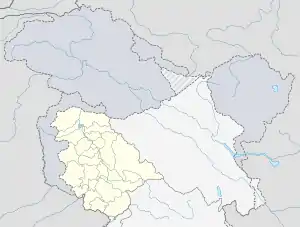Lakhanpur, Jammu
Lakhanpur is a town and a notified area committee in Kathua district in the Indian union territory of Jammu and Kashmir. Lakhanpur is the entrance to Jammu and Kashmir from Punjab and rest of India. It is a sparsely populated area about 20 kilometers from the center of Kathua district.
Lakhanpur
Lakhanpur | |
|---|---|
Town | |
 Lakhanpur Location in Jammu and Kashmir, India  Lakhanpur Lakhanpur (India) | |
| Coordinates: 32.410561°N 75.614403°E | |
| Country | |
| Union Territory | Jammu and Kashmir |
| District | Kathua |
| Population (2011) | |
| • Total | 3,461 |
| Languages | |
| • Official | Hindi |
| Time zone | UTC+5:30 (IST) |
Geography
Lakhanpur is situated just below the Sivalik Hills. The town is sandwiched between Ravi river to the south and east while the Shiwaliks rise abruptly 400 metres (1,300 ft) high to the north. The town starts from the Modhopur Ravi bridge and is spread on both the sides of NH1A. Kathua city is just 6 km ahead of Lakhanpur. It is the gateway to the Indian state Jammu and Kashmir.
Traffic and infrastructure
Since the town is an entrance to the state, the infrastructure is well developed with parking, restaurants, banks, ATMs, sanitation facilities and much more. But the traffic problem is difficult, with hours of traffic snarls due to the huge rush of trucks, buses and cars. The toll plaza serves as a source of income to the state as well. Other than one of the major toll collecting plazas in the state, The town is also known for its fort, hence the name Lakhanpur fort which is now turned into a devi temple.
Lakhanpur used to be the place of a major toll of traffic and goods entering the union territory. The toll was officially abolished on January 1st 2020.[1]
Demographics
As of 2001 India census,[2] Lakhenpur had a population of 1521. Males constitute 53% of the population and females 47%. Lakhanpur has an average literacy rate of 77%, higher than the national average of 59.5%: male literacy is 81%, and female literacy is 73%. In Lakhenpur, 12% of the population is under 6 years of age.
Religion
Hindu 89.28%, Sikh 3.18%, Muslim 5.11%, [3]
See also
References
- https://m.tribuneindia.com/news/lakhanpur-toll-abolition-set-to-boost-construction-work-26153
- "Census of India 2001: Data from the 2001 Census, including cities, villages and towns (Provisional)". Census Commission of India. Archived from the original on 16 June 2004. Retrieved 1 November 2008.
- http://www.census2011.co.in
